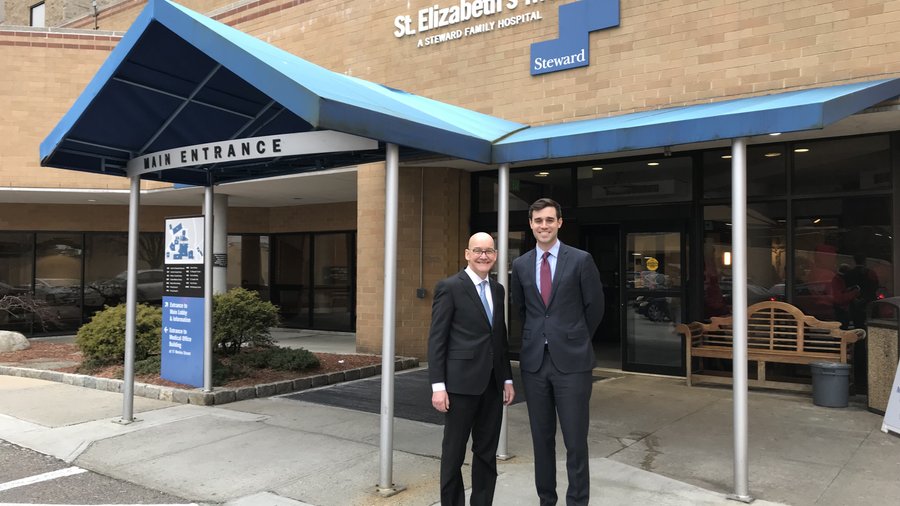When the Connell building was constructed on St. Elizabeth’s Medical Center campus in 2009, hospital leaders had a vision — one day it would house three floors of some of the hospital’s sickest patients.
The hospital is fulfilling the final part of that vision this year, as part of a massive upgrade to the Brighton-based campus. The work, the cost of which has not been disclosed, will add an additional 10 ICU beds to the hospital’s existing 27, another 12 medical surgical beds to the hospital’s 118, and another two operating rooms to the hospital’s current 13, all on the 20,000-square-foot third floor of the building.
Elsewhere on the campus, St. Elizabeth’s is investing $100 million in a 206,000-square-foot, six-story parking garage; a 2,300-square foot EMS facility; new front entry and lobby; and some exterior and infrastructure upgrades to its Center for Biomedical Research Building.
Also planned is the renovation of two operating rooms, consolidate outpatient mental health services to another part of the hospital, and renovations to a cardiac catheterization space. All are scheduled to be complete by the first quarter of 2021.
According to hospital executives and officials from the parent organization, Dallas-headquartered Steward Health System, the progress is a testament to the growing success of the broader Steward model, which seeks to keep local patients from going into Boston hospitals by better coordinating their care. In this model, the hospital also receives a set reimbursement for a group of patients to incentivize doctors to keep care at less expensive, local hospitals.
“This integrated model has really taken hold, as the Steward model from day one has taken hold,” said St. Elizabeth’s President Harry Bane. “It’s the whole idea of coordinating care amongst other institutions and having the transitions of care (from one of our hospitals to another)."
They say they're not building the facilities to draw more patients. The patients are already coming to St. Elizabeth's, Bane said. In cardiac surgery alone, St. Elizabeth’s went from caring for 250 cases in 2013 to 710 in 2018. The hospital has seen comparable growth in services like robotic urology. Of the hospital’s 27 ICU beds, an average of 24 or 25 are occupied on any given day.
The growth in patients has been matched by the growth of Steward’s physician network, said Dr. Mark Girard, Steward President of the Northeast Hospital Region.
“We've had a tremendous growth in both primary care and specialists who would wanted to be part of this integrated healthcare system. And with that has come more volume both locally and obviously here at Saint Elizabeth,” Girard said.
Much as the previous projects have before it, the latest build-out is also in an effort to recruit talent, Bane said. St. Elizabeth's has 2,198 employees.
In a recent tour of the now-empty space, Bane pointed to a floor markup of the new hybrid imaging and operating rooms being constructed.
Total 2017 net patient service revenue
| Rank | Prior Rank | Hospital/Prior rank (*unranked in 2017)/ |
|---|---|---|
1 | 1 | Massachusetts General Hospital |
2 | 3 | Brigham and Women's Hospital |
3 | 2 | UMass Memorial Medical Center |
The investments are coming in Massachusetts despite the company’s national focus. Steward Health acquired eight hospital Community Health Systems in 2017, and then acquired another 18 hospitals with the acquisition of Iasis Healthcare later the same year.
Steward, which has more than 40,000 employees total, is owned by Cerberus Capital Management, a New York private equity firm.
Even still, Steward said they are investing in their local institutions. The company has invested $600 million at all its hospitals since its founding in 2010, and is projected to invest another $400 million by 2021.
The new clinical space St. Elizabeth’s will sit on top of the hospital’s emergency department, which opened in 2009 on the first floor, and its current ICU, which opened in 2013 on the second floor.
Unlike majority of the non-profit hospitals in the state, Girard said that the for-profit hospital will pay for the renovations out of its own profits, with the system financially stable enough to support the investment.
In fact, according to the most recent financial data from the state’s Center for Health Information and Analysis, five of Steward’s six hospitals were operating in the black in fiscal 2017. All the profitable hospitals were earning total margins of 3.4 percent or higher — better than half of all the acute care hospitals in the state. Steward’s Saint Anne’s Hospital also reported the highest operating margin of any hospital in the state that year, at 12.6 percent.
The financial success is a far cry from the health system’s meager beginnings in 2011, when four of the then six hospitals under the Steward brand were operating in the red.
Girard said the system wasn’t done expanding within Massachusetts, with Steward also looking to grow its physician network.
“The model is all centered on the doctor-patient relationship, and the more we can bring primary care into the integrated healthcare system, and the more we can bring the supporting specialists to meet the needs of those primary care docs and the patients they serve, then the more good we can do,” Girard said.











